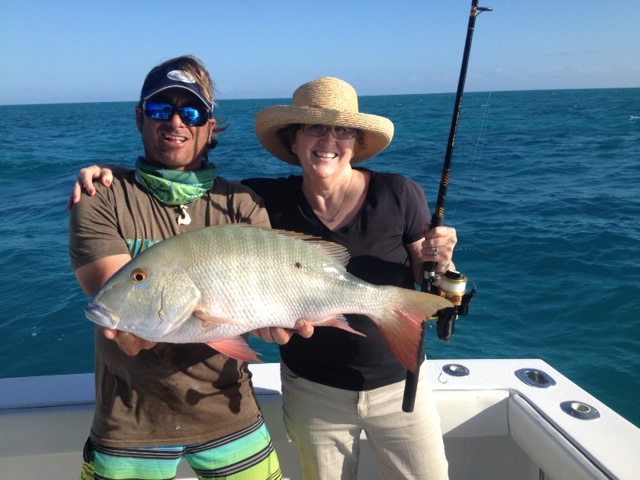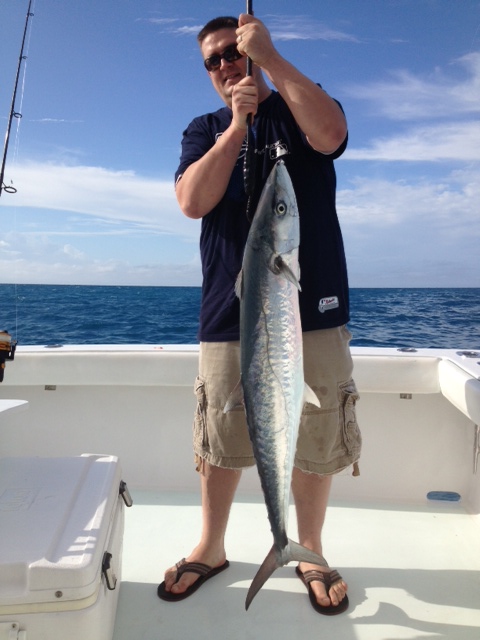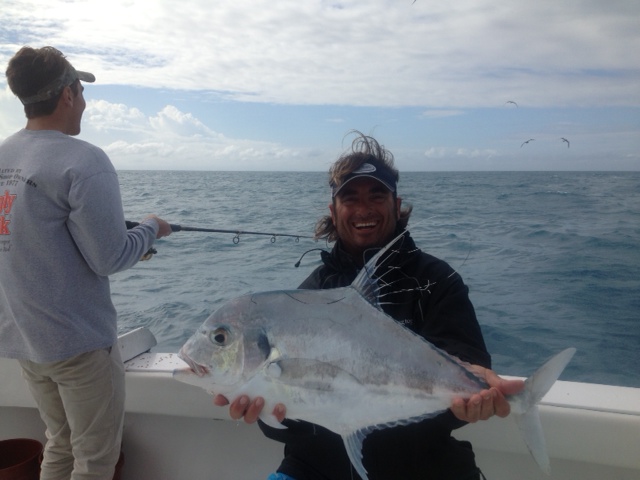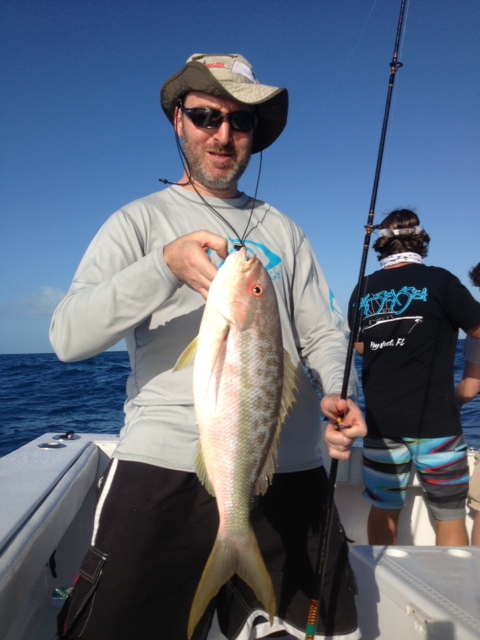This monthâs fishing report might be more accurately titled, my northern fishing vacation. Just as many of my readers leave the local area during the heat and humidity of Hurricane season, I too like to get away and wet a line in an utterly different fishing venue. This year I traveled to Wedgeport Nova Scotia to participate for the second year in a row in the annual Wedgeport Tuna Tournament. This 4 day event at the end of August attracts a fleet of âworkingâ boats, (there is no such thing as a sportfishing boat in this area) who compete to catch the largest Bluefin Tuna, of which only one may be weighed per boat, or go for the greatest combined poundage of Bigeye Tuna and Long Finned Albacore.
The largest Bluefins are always caught on the various 30 fathom banks within 20 miles of shore while the Bigeyeâs and Albacore are caught along the edge of the continental shelf which is 100 miles away. None of the participating boats has a cruising speed above 8 knots so they must strategize whether to make the long run offshore and remain at sea for the entirety of the tournament or stay inshore and target the Bluefins. Our group chose to fish for one large Bluefin, knowing that if we got lucky early, we could return to the wharf and rejoin the dockside merriment with a fish on ice, ready for the weigh in at the end of the tournament.
At 7:00 pm on Aug 22nd a lit flare and a blast from an air horn signaled to the assembled fleet that the tournament was on. Our destination was German Bank, a plateau of 30 fathom water lying some 20 miles south south west of Wedgeport. The Herring boats were reporting good catches from this area. Herring comprise the main food source for all the large Marine predators including Whales, Seals, and Bluefin Tuna. Find Herring and you will find Bluefins.
Three hours after leaving the dock we were located on the Bank. Twinkling lights near and far signaled the presence of the Herring fleet, a combination of Purse Seiners which wrap a net around a school and Gill netters who set a vertical net on the bottom. Herring fishing is done exclusively at night when the Herring rise higher off the bottom. There are strict seasons and catch quotas now for Herring as fisheries managers have come to understand the importance of Herring in the food chain.
We set up a drift close to a group of Seiners who were hauling back, knowing that Bluefins are often attracted to the scales and fallout herring from the nets. We had our own Herring aboard, some 500 pounds, and began the methodical process of chunking and chumming to attract the feeding Tuna. In the wheel house our Captain anxiously watched the depth machine for signs of the Tuna âmarkingâ under the boat. Our Tackle was as big as it comes in the world of rod and reel fishing, the equivalent of Elephant guns. Shimano Tiagra 130 class reels filled with 200 pound test Dacron and a header of 200 pound test mono. These reels were mounted on custom roller guide rods with aluminum bent butts. Fished out of a fighting chair gimbal and a bucket harness, an experienced angler can exert over 75 pound of drag to subdue a Giant Bluefin which is by a wide margin the most powerful fish in the ocean. We rigged 3 herring baits and deployed them at staggered depths as we chunked and drifted. Every hour or so we would pick up and move back up current to cover another section of the bank.
Located at the mouth of the Bay of Fundy, this area has tremendously strong currents and some of the largest tidal changes in the world. As the night wore on we had periodic visitations from Grey Seals and several times heard the great inhalation of whales in the darkness, but we didnât mark the Tuna and we didnât get a bite. The air temperature dropped and a heavy mist drenched us with a clammy cold. The water temperature was 54 degrees. I found myself adding layers for warmth and donning full rain gear. At dawn, stiff and cold we began dropping quill rigs down to the bottom in hopes of hooking a few live herring to deploy on our Tuna hooks. For some reason the Herring never bite a quill at night so this was our first opportunity to try for live bait. No sooner did the first quill hit bottom and load up with quivering bait than the light rod bowed up and then straightened, something had eaten the quill off. Moments later the deep rod seemed to get very heavy but the drag didnât immediately crack.
We had something on but it seemed more like a Porbeagle Shark which infest these cold waters. Speculation turned to a Seal as the line angled up, still without any drag being taken. Just as we became certain it couldnât be a Tuna- whatever it was wasnât pulling hard enough, line started peeling off the spool and very quickly the mono header was off and we were well down in the backing. Nothing but a Tuna could sustain such a run against the 60 pound drag setting. Twenty five minutes later the fish was in sight, circling slowly 20 feet down. It was a good fish probably close to 500 pounds but maybe not a winner. We deliberated about whether to take the fish and decided slow as the fishing was, having one in hand was better than hoping to hook a bigger one. Leadering a giant Tuna requires strength, finesse and no small amount of courage. The idea is to make the fish swim towards the leader man as he shortens on the leader and then hold his head so he doesnât turn and kick back off, all the while avoiding pulling the hook or breaking the leader. This time it was deftly accomplished and within minutes thanks to a hydraulic boom, the fish was aboard. We noticed in examining the fish the remains of our quill rig protruding from his mouth. After a few quick pictures, the fish was lowered into an ice filled slush tank for the ride in.
Two days later at the weigh in our fish tipped the scales at 501 pounds gutted. It was the second largest caught in the event. The winning fish was also caught in the same location and weighed 676 pounds, thatâs a lot of Sushi!
Next month, back to the local fishing report.
Capt. Brad Simonds



 We extend best wishes for a Happy New Year. Key West Charter Fishing aboard the SOUTHPAW has yielded a mixed bag of fish over the Christmas holidays. We’ve caught a few Sailfish, a few Dolphin, a few Kings, a few Grouper, some snapper and some Cero. Bonita’s, Horse eye Jacks and other assorted members of the Jack Genus have thankfully enlivened several trips. The truth is fishing has been pretty slow of late so we have had to work hard on some days to produce good action. Here are a few good fish caught over the last week.
We extend best wishes for a Happy New Year. Key West Charter Fishing aboard the SOUTHPAW has yielded a mixed bag of fish over the Christmas holidays. We’ve caught a few Sailfish, a few Dolphin, a few Kings, a few Grouper, some snapper and some Cero. Bonita’s, Horse eye Jacks and other assorted members of the Jack Genus have thankfully enlivened several trips. The truth is fishing has been pretty slow of late so we have had to work hard on some days to produce good action. Here are a few good fish caught over the last week.